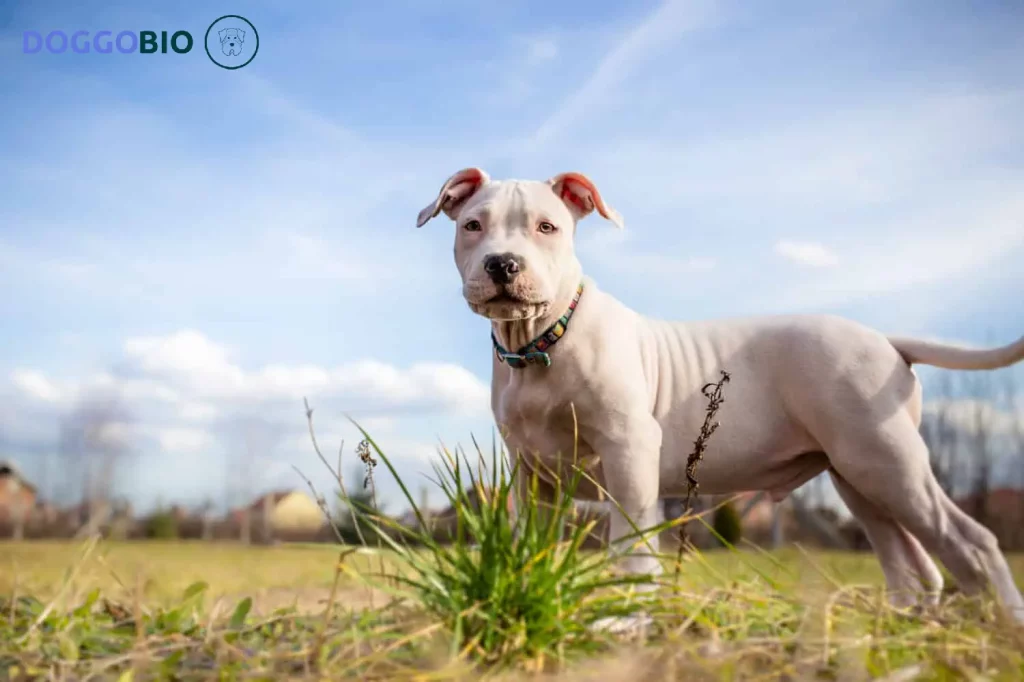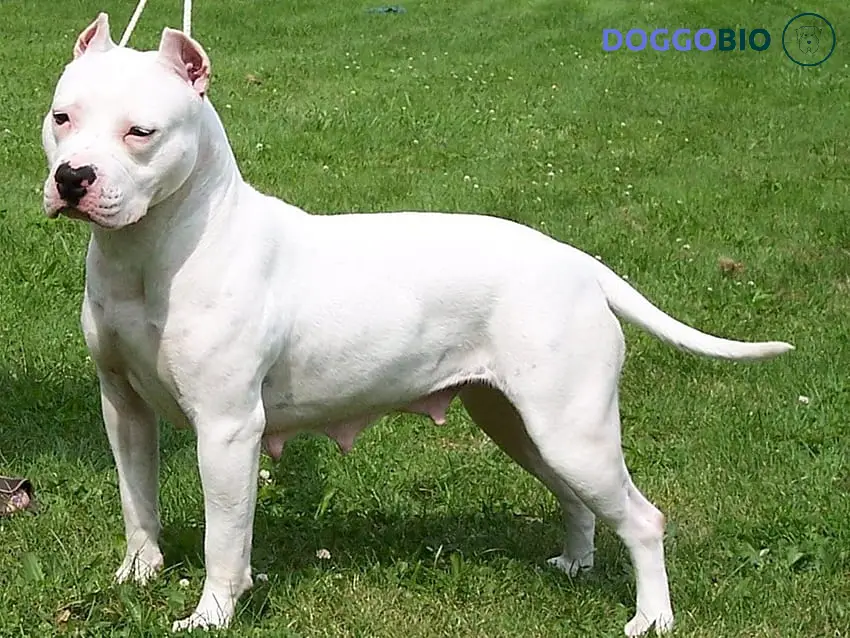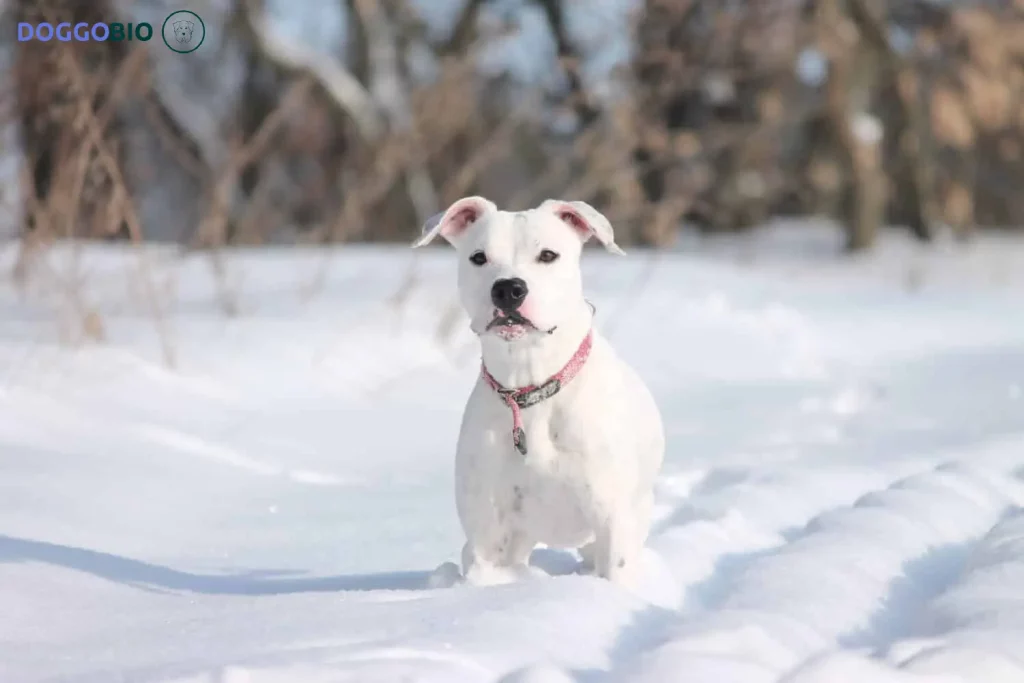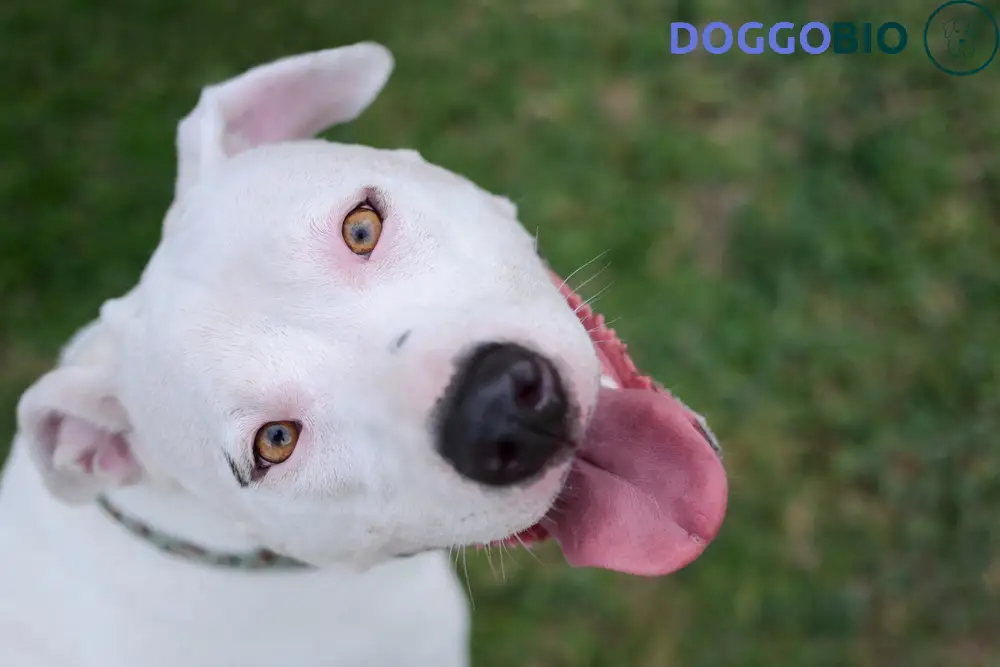White Pitbulls are a stunning and distinctive variation of the popular dog breed. With their striking white coat and muscular build, these dogs have often been sought after as pets due to their loyal and affectionate nature.
However, white Pitbulls are also controversial due to misconceptions and stigmas surrounding their breed.
In this article, we will explore white Pitbulls’ history, characteristics, and care requirements, so that you can learn more about this beautiful and misunderstood breed.
What is a White Pitbull?

These White Pitbulls are no different than their colored counterparts. They belong to the Pitbull family, with the American Pit Bull Terrier being the most common one with this rare white coat.
Can you believe it? White is not a standard color for Pitbulls! It makes these dogs stand out from the pack, quite literally. So if you happen to come across a White Pitbull, don’t forget to take a closer look and admire its unique beauty.
History of White Pitbull
Have you ever wondered how an all-white Pitbull came to be? It all goes back to the 19th century when Terriers and Bulldogs were crossbred to create the Pitbull for dog fighting. However, this inhumane practice was banned, and the dog was transported to America. Despite its bad reputation as a bully breed, the American Bully gained popularity as a family dog.
Now, let’s talk about the White Pitbull, which is essentially the same breed as the American Pitbull Terrier, with the only difference being the coat color. So, how did this unique coat color come to be? It all comes down to genetics.
Each parent contributes half of a gene, which forms a whole gene for the puppy. These genes can either be dominant or recessive, but the dominant genes usually overpower the recessive ones. The locus “A” allele determines the base coat color of all Pitbulls, which can be black or red.
Also, four “S” alleles determine the white coloring, with the “S” gene creating the solid white coat color. However, it’s important to note that a White Pitbull might not be a true White Pittie. It could be Albino or Leucistic.
Albino Pitbulls lack pigmentation in their blood vessels, eyes, hair, and skin due to a rare genetic mutation passed on by both parents. Unfortunately, this condition also makes them prone to several health issues. In contrast, Leucistic Pitbulls have no melanin in their fur and low levels of pigmentation in their other features.
So, how can you tell the difference between an Albino and a Leucistic Pitbull? Albino Pitbulls have translucent or light blue eyes, while Leucistic Pitbulls have slightly bluer eyes and deeper pink features.
While White Pitbulls may be a popular breed due to their striking appearance, breeding them may be unethical due to health issues. Despite this, kennel clubs such as the United Kennel Club (UKC) recognize this breed in all coat colors and markings except for Merle. Meanwhile, the American Kennel Club (AKC) recognizes the American Staffordshire Terrier, which is essentially the same breed but with more limited colors and markings. The Pittie is not recognized if it has over 80% pure White on its coat.
Is White Pitbull different from other Pitbull?
White Pitbulls, with their unique coat color, possess the same personality traits as other Pitbulls but have some distinguishing features. These dogs have a heightened sensitivity to sunlight, especially those with red noses, which puts them at risk of skin damage and cancer. Therefore, keeping them indoors or under shades while walking them is essential.
Moreover, White Pitbulls have a high demand due to their rarity, making them more expensive than other variations. These dogs have a unique genetic makeup that causes partial loss of pigmentation and recessive traits ideal for some breeding programs. Hence, White Pitbulls are often used in breeding programs to produce offspring with desirable characteristics.
What Does a White Pitbull Look Like?

At first glance, they may seem like any other Pitbull, but the absence of pigment in their fur makes them stand out uniquely. These dogs are white, with brown noses, lips, and paw pads. The exact shade of brown can vary considerably, adding an element of unpredictability to their appearance.
One of the most striking features of white Pitbulls is their eye color. Many people assume that all white Pitbulls have blue eyes, but this is not always true. Eye color is affected by several factors, including coat color. Generally, lighter-colored Pitbulls tend to have lighter-colored eyes. However, it’s important to note that not all white Pitbulls will have blue eyes. Light brown eyes, and even dark brown to a lesser extent, are equally possible.
Despite their muscular and powerful-looking physique, white Pitbulls are pretty agile and graceful in their movements. They have relatively broad heads and very defined jaws, adding to their commanding presence. These dogs are incredibly athletic and excel in activities that require physical strength and agility. Overall, white Pitbulls are a unique and impressive breed that stands out in their appearance and abilities.
Size, height, and weight
White Pitbulls are known to grow to a height range of 17 to 21 inches (43.1 to 53.3 cm), and their weight may fall between 30 to 65 pounds (13.6 to 29.4 kg). You must know that male Pitbulls tend to be more massive than females and may weigh more than them. The female Pitties, on the other hand, are lighter in weight.
Additionally, males may exhibit higher levels of aggression and have a broader bone structure. Conversely, female White Pitbulls may fetch a higher price in the market for breeding, as they can produce more White Amstaffs. So, it is imperative to consider gender while choosing a White Pitbull.
Coat colors and types
White Pitbulls possess a short coat, which is their signature look. A solid white coat or a mix of other patterns and colors makes them stand out. One such popular pattern is a black and white coat that resembles that of a cow, which people fondly refer to as a Moo Moo Pitbull. These dogs can have other color spots on their body, such as brown or tan, along with the dominant white color. Conversely, some Pitbulls may be predominantly black, with white markings for good measure.
But how do these unique patterns emerge? It’s a mystery that has puzzled many experts, but one theory is that it’s due to a genetic anomaly during breeding. The coming together of genes could have produced these distinctive patterns that make White Pitbulls one of the most sought-after breeds in the world.
Temperament and Personality
The Pitbull is one of the most misunderstood dog breeds in the world, including the white Pitbull. Due to misinformation and misconceptions, this breed is often viewed as inherently violent and excessively aggressive, leading to “breed bans” in many places. However, no evidence suggests this breed is naturally more aggressive than any other breed. According to an American Veterinary Medical Association study, a dog’s breed has no inherent connection to aggression. Instead, proper training and socialization play a much more significant role in determining a dog’s temperament.
It’s essential to understand that dogs can become aggressive if they aren’t handled and socialized appropriately. For example, if you never introduce your dog to strangers, your dog may react poorly whenever you bring a stranger into your home.
In contrast to popular belief, the American Kennel Club describes Pitbulls as intelligent, friendly, and confident dogs. They are incredibly people-oriented and love everyone, whether they are family members or strangers. For this reason, Pitbulls are not recommended as guard dogs. A well-socialized Pitbull is likelier to lick someone rather than bite them, even if that stranger breaks into your home.
Pitbulls are incredibly loyal dogs that are devoted to their owners and families. Unlike other breeds, they are not territorial and happy to share attention with strangers. For this reason, they are often considered excellent family dogs.
Pitbulls are often great with children, as their size allows them to tolerate more disorderly behavior. Additionally, their fearlessness prevents fear-based biting, which is common in smaller breeds. However, their vitality and energy can sometimes result in children being knocked over. Regular exercise and mental stimulation can help to curb this behavior, ensuring that your Pitbull remains well-behaved and well-adjusted.
Is White Pitbulls a good fit for families?
The question of whether White Pitbulls make good family dogs is one that many people have asked. Despite the negative reputation that Pitbulls have received due to their involvement in dog fighting, White Pitbulls are loving and loyal companions that can make excellent family pets.
White Pitbulls are very affectionate and enjoy spending time with their family, including children. They have a playful and friendly nature and are always up for a game of fetch or a cuddle on the couch.
While they are not known for being guard dogs, White Pitties are generally friendly with everyone and can make great “nanny dogs” to watch over children. However, they may be prone to separation anxiety, leading to destructive behavior if left alone for too long. In these cases, it’s essential to redirect their behavior and reward positive behavior rather than isolating or punishing them.
It’s important to note that White Pitbulls are not inherently aggressive, and any aggressive behavior is usually a result of poor breeding, socialization, or mistreatment. With proper training and socialization, White Pitties can make wonderful family pets that bring joy and love to any household.
Is White Pitbulls aggressive?
White Pitbulls can exhibit aggressive behavior without proper training and socialization like any other dog breed. However, with early socialization and formal training, these dogs can get along fine with other pets in the household.
Due to their history, they may tend to chase and hunt down small animals such as rodents. Therefore, watching them is essential if you have small animals at home.
While White Pitbulls are considered friendly today, they may still have aggressive tendencies. However, proper training and socialization can help prevent any potential issues.
Training

It’s no secret that Pitbulls, especially white ones, are often misunderstood and unfairly labeled as aggressive dogs. However, with the proper training and exercise, these loyal and people-oriented dogs can make excellent companions.
Training a white Pitbull can be a bit of a challenge, but not impossible. These dogs are eager to please their owners but can be easily distracted. Pitbulls are more single-minded than other breeds with intense focus, such as German Shepherds and Poodles. Moreover, they can be sensitive to harsh training methods, which can lead to disobedience. Therefore, the best approach is positive reinforcement training that involves a lot of praise and treats.
Exercise Requirements
White Pitbulls have an unrelenting drive and a zest for life that demands at least 60 minutes of daily exercise. However, you need to do more than a stroll and call it a day with these athletic dogs. It would help if you challenged their minds and bodies with fun games and puzzles to keep them engaged.
If you don’t give your White Pitbull enough exercise, it will get bored and turn its attention to your personal belongings, turning them into chew toys. Shoes, clothes, and furniture are just the tip of the iceberg. And if they don’t get enough exercise, they could become overweight, leading to various health problems. So keep your White Pitbull active to avoid unwanted behavior or health issues.
Grooming and Cleaning
White Pitbulls have a reputation for being more high-maintenance than their counterparts regarding grooming. Despite being accessible to the groom, their white coat is prone to getting dirty quickly, making it necessary to give them more frequent baths than other Pitbulls with darker-colored fur.
However, it’s crucial to note that White Pitbulls have delicate skin, and using hot water or soap can strip their coat of natural oils, leading to dry and itchy skin. As a result, it’s recommended to minimize the use of hot water and instead use mild shampoos or soaps to protect sensitive skin.
Even though Pitbulls shed all year round, their short fur doesn’t cause much of a mess. Brushing them twice weekly can help and keep their skin clean. Unlike other breeds, white Pitbulls do not require haircuts because of their natural shedding process.
Food and Diet
White Pitbulls have high energy levels and muscular bodies, so they need a protein-rich diet. The optimal protein sources for these dogs include chicken, turkey, and beef, while mutton and pork should be fed in moderation as they are high in fat.
While meat is crucial, including fruits and vegetables in your White Pitbull’s diet is also essential. Apples, bananas, coconut, pumpkin, sweet potatoes, and peanut butter are great non-meat options that provide necessary vitamins and carbohydrates.
If you prefer store-bought dog food, ensure it’s high in meat and low in grains. Dry food or kibble is ideal for Pitbulls because of their low-fat content. Depending on your White Pitbull’s size, health, and age, feed them 1.5 to 2.5 cups of kibble daily, divided into two or three meals to keep them satiated throughout the day.
Common Health Issues
But even with a reputable breeder, there are still some health issues that Pitbulls may experience.

1.Hip dysplasia
Hip dysplasia is common in larger dog breeds like Pitbulls. It’s caused by improper hip joint growth, leading to misalignment and potential arthritis. Genetics and environmental factors, such as overfeeding and overexercising, contribute to this condition.
Early symptoms appear before four years of age, and though less severe in Pitbulls, vigilance is still crucial.
2.Allergies and Skin Problems
White Pitbulls commonly experience allergies, often due to their diet, resulting in skin issues. Itchy paws and excessive grooming are common symptoms. Dogs may develop sores from biting and licking, leading to infections that can be fatal.
Working with a vet is crucial to identify the allergen and switch to an appropriate diet. Lifelong adherence to a special diet is essential to prevent severe symptoms and infections.
3.Urinary Tract Infections
Pitbulls are prone to urinary tract infections (UTIs), which can cause them to urinate indoors. Symptoms vary, including holding urine for too long, minor accidents, or difficulty urinating.
UTIs may progress to bladder infections and stones if untreated. Vets can easily treat UTIs with medication, so seek help if you suspect your Pitbull has one.
4.Autoimmune Disorders
Autoimmune disorders in Pitbulls can be puzzling. The immune system may attack healthy cells instead of invaders, causing various symptoms. The exact cause is unknown, with genetics and environment being potential factors.
There is no cure, but symptom management and prevention of further damage are key. Hormone replacement and other therapies may be necessary.
5.Heart disease
Congenital heart disease affects puppies during development, resulting in abnormal heart formation. Genetics and environmental factors contribute to these conditions. Pitbulls are more susceptible to genetic heart conditions, complicating breeding.
Testing can help, but complete prevention is impossible due to multiple involved genes. Severity varies, and some cases may go unnoticed until later in life.
6.Cataracts
Cataracts are an eye condition that affects many Pitbulls, including those with a white coat. When a dog has cataracts, their eye lens becomes cloudy or opaque, causing vision impairment. Dark-eyed White Pitbulls are particularly susceptible to developing cataracts.
7.Blindness
Do you know what’s not so great for a White Pitbull? Blindness. And unfortunately, if your furry friend has light-colored eyes, they’re more likely to suffer from this affliction. The lovely blues, pinks, and reds aren’t as protective against bright light as brown or black eyes, meaning that light-eyed White Pitbulls are at a higher risk of going blind.
So, if you want to ensure that your pup can see the world around them, invest in some doggy sunglasses (yes, they exist!) or keep them out of bright sunlight as much as possible.
How Long Do White Pitbulls Live?
White Pitbulls are an incredibly sturdy and robust breed. They enjoy the same longevity as their colored Pitbull counterparts, average lifespan for 12 to 16 years. They make for long-term, reliable companions.
Unfortunately, if your White Pitbull has albinism, it might not be as fortunate in the lifespan department. Albinism can cause vision and hearing problems, which may significantly impact their quality of life and lifespan.
Is White Pitbull Right For Me?
If you’re looking for a furry companion that’s both loving and full of energy, a White Pitbull might be the perfect fit. However, it’s essential to note that Pitbulls are not ideal for first-time dog owners.
Pitbulls can be headstrong and require a confident owner who can take charge. They are affectionate and devoted but need plenty of exercise and mental stimulation to thrive. Additionally, White Pitbulls are prone to separation anxiety. If you’re away from home for extended periods, you might return to find your puppy acting out due to boredom and stress.
But, if you’re an active person or family and can provide your pup with the love, attention, and exercise they need, then a White Pitbull might be an excellent addition to your household.
Some Posts You Wanna Read More
- Grey Pitbull
- Tri Pitbull
- Blue Nose Pitbull
- Are Pitbulls Good With Kids?
- Do Pitbulls Shed A Lot?
- Are Pitbulls Hypoallergenic?
- How Long Are Pitbulls Pregnant For?
- How Long Do Pit Bulls Live?
- Is Pedigree Good for PitBulls?
Frequently Asked Questions
Does White Pitbull Shed A Lot?
Yes, they do. White Pitbulls might have a short coat, but they still shed! That means this puppy is not the right fit for you if you have allergies.
However, brushing your dog once a week should help keep shedding under control. And when the shedding season comes around, you should brush them more often to keep your house fur-free.
Is White Pitbull High Maintenance?
White Pitbulls are not considered high-maintenance dogs. They are low-maintenance and don’t require much special attention or grooming. They are happy to go with the flow and enjoy doing whatever their owner does.
When it comes to weather, these puppies are versatile. Rain or shine, hot or cold, they’re down for anything. However, due to their light fur, White Pitbulls are more susceptible to skin damage from prolonged sun exposure. So, keeping them in the shade or providing sunscreen protection when outdoors for extended periods is essential.
White Pitbulls are an excellent choice for pet owners looking for a low-maintenance, easy-going companion.
Are White Pitbulls Rare?
Yes, white Pitbulls are relatively rare compared to other coat colors like black, fawn, brown, and brindle. White coat color in Pitbulls does occur naturally, but it is not as common as these other variations.
White Pitbulls are considered more coveted by Pitbull enthusiasts, and this rarity can sometimes lead some breeders to take unscrupulous measures to exploit its exclusivity.
Does White Pitbull have locking jaws?
No, White Pitbulls do not have locking jaws. This is a false misconception. There is no special mechanism in their jaws that prevents them from fully opening or closing their mouths. The idea of Pitbulls having locking jaws is a myth that has been circulated over time.
In reality, the structure of their jaws is no different from that of any other breed of dog. So, you can rest assured that your White Pitbull’s jaws will not lock, and you can train and socialize them like any other breed without any unique concerns.
Is White Pitbull Different From White Rhino Pitbull?
Yes, White Rhino Pitbulls are different from White Pitbulls.
The White Rhino Pitbull is a distinct breed known for its predominantly white coat, which is even whiter than the average White Pitbull. In fact, white is the base coat color for the White Rhino Pitbull, and it can also have markings or other colors, such as brown or black, in addition to white.
In terms of their physical build, White Rhino Pitbulls are similar to other Pitbulls. However, what sets them apart is their eye color. Unlike White Pitbulls, White Rhino Pitbulls can have eyes of any color except blue. This makes them unique and differentiates them from the typical White Pitbulls, which may have blue eyes. So, while both breeds may share some similarities, the difference in coat color and eye color is a notable distinction between White Pitbulls and White Rhino Pitbulls.
Does White Pitbull Have Blue Eyes?
White Pitbulls can indeed have blue eyes. As puppies, their eyes may start as a striking baby blue, but they often become a more typical brown or hazel color as they mature.
However, some White Pitbulls may retain their baby blue eyes or develop a striking blue hue considered a breed defect. Despite this, many people still find blue-eyed White Pitbulls captivating and would love to own one.
Are White Pitbull Deaf?
White Pitbulls being deaf is a misconception that needs to be cleared up. As long as they’re not albino or leucistic, White Pitbulls are not deaf, and their hearing is just as perfect as any other dog. There is no evidence to suggest that White Pitbulls are more likely to be deaf than dogs of different coat colors.
However, if you have a person with albinism or a leucistic Pitbull, their chances of being deaf are relatively high. The absence of melanin in their ears can disrupt their hearing, and they may be born deaf or develop deafness later in life. So, it’s crucial to understand the difference between a regular White Pitbull and a person with albinism or a leucistic one, as their hearing ability can be drastically different.
Conclusion
In conclusion, white Pitbulls are a unique and beautiful variation of the Pitbull breed, known for their striking white coat and muscular build. Despite misconceptions and stigmas surrounding their breed, white Pitbulls are loving, loyal, and affectionate pets that can make excellent companions for families and individuals.
To ensure that your white Pitbull lives a happy and healthy life, providing them with proper nutrition, exercise, veterinary care, socialization, and training is essential. By taking the time to understand and care for your white Pitbull, you can enjoy a lifetime of companionship and joy with this beautiful breed.

Pingback: Tri Color Pitbull: Unveiling the Fascinating World 2023
Pingback: Blue Nose Pitbull: Unveiling The Mystery of Unique Breed 2023
Pingback: The Truth About Pitbull Lifespan: How Long Do Pitbull Live? 2024